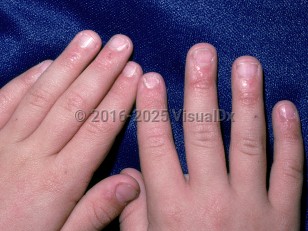Dyskeratosis congenita in Adult
See also in: Nail and Distal DigitAlerts and Notices
Important News & Links
Synopsis

Dyskeratosis congenita is a rare genetic multisystem disorder related to abnormalities with telomere shortening. It is characterized by reticulated hyperpigmentation of the neck, face, and trunk, palmar hyperkeratosis, premalignant leukoplakia, and nail abnormalities. The most common nail abnormalities are longitudinal ridges, pterygium, or atrophic / absent nails.
The condition also may cause lacrimal duct atresia with excessive tearing, and bone marrow failure with consequent anemia, thrombocytopenia, or pancytopenia. Hyperhidrosis of palms and soles, blister formation, acrocyanosis, hair loss (scalp), and early tooth loss also occur.
Pneumonia and sinusitis, likely due to defective humoral immune system (dysgammaglobulinemias), are common. Suppression of cellular immunity is evidenced by opportunistic infections with Pneumocystis pneumonia and cytomegalovirus. Pancytopenia, Fanconi type, is a possible complication. Death by the third decade from bone marrow failure, infection, malignancy (squamous cell cancer, usually of mucous membranes, acute myelogenous leukemia, or Hodgkin disease), pulmonary fibrosis, or liver cirrhosis is a frequent occurrence.
Dyskeratosis congenita has an X-linked recessive inheritance, most frequently, or may be inherited in an autosomal recessive or dominant fashion.
The condition also may cause lacrimal duct atresia with excessive tearing, and bone marrow failure with consequent anemia, thrombocytopenia, or pancytopenia. Hyperhidrosis of palms and soles, blister formation, acrocyanosis, hair loss (scalp), and early tooth loss also occur.
Pneumonia and sinusitis, likely due to defective humoral immune system (dysgammaglobulinemias), are common. Suppression of cellular immunity is evidenced by opportunistic infections with Pneumocystis pneumonia and cytomegalovirus. Pancytopenia, Fanconi type, is a possible complication. Death by the third decade from bone marrow failure, infection, malignancy (squamous cell cancer, usually of mucous membranes, acute myelogenous leukemia, or Hodgkin disease), pulmonary fibrosis, or liver cirrhosis is a frequent occurrence.
Dyskeratosis congenita has an X-linked recessive inheritance, most frequently, or may be inherited in an autosomal recessive or dominant fashion.
Codes
ICD10CM:
Q82.8 – Other specified congenital malformations of skin
SNOMEDCT:
74911008 – Dyskeratosis congenita
Q82.8 – Other specified congenital malformations of skin
SNOMEDCT:
74911008 – Dyskeratosis congenita
Look For
Subscription Required
Diagnostic Pearls
Subscription Required
Differential Diagnosis & Pitfalls

To perform a comparison, select diagnoses from the classic differential
Subscription Required
Best Tests
Subscription Required
Management Pearls
Subscription Required
Therapy
Subscription Required
References
Subscription Required
Last Reviewed:04/20/2017
Last Updated:01/13/2022
Last Updated:01/13/2022
Dyskeratosis congenita in Adult
See also in: Nail and Distal Digit
